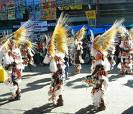



The Ati-Atihan Festival is a feast held annually in January in honor of the Santo Niño (Infant Jesus), concluding on the third Sunday, in the town of Kalibo, Aklan in the Philippines. The festival consists of tribal dance, music, accompanied by indigenous costumes and weapons, and parade along the street. Christians and non-Christians observe this day with religious processions.
History
A 13th century (c.1200 A.D.) event explains the origins of the festival. A group of 10 Islamic warriors, Malay chieftains called Datu, fleeing from the island of Borneo settled in the Philippines, and were granted settlement by the Ati people, the tribes of Panay Island. The Ati-Atihan was originally a pagan festival who worshipped Islam, Animism, and their anito. Spanish missionaries gradually added a Christian meaning. Today, the Ati-Atihan is celebrated as a religious festival. Another version was that somewere in the 16th or 17th century, the Filipino and Spanish Christians in Aklan were in constant threat of muslim pirate attacks. Then one night the people of the island covered themselves with coal, in an attempt to mimic the Ati people. When the muslims came, they thought they saw real atis. They were known as fearsome warriors at that time- so the muslims fled the area.
Events
The people attend masses for the Santo Niño, and benefit dances sponsored by government organizations. The formal opening mass emphasizes the festival’s religious event. The procession begins with a rhythmic drumbeats, and dances parading along the street. The second day begins at dawn with a rosary procession, which ends with a community mass, and procession. The highlight of the festival occurs on the last day, when groups representing different tribes compete. The festival ends with a procession of priest carrying torches, and different images of the Santo Niño. The contest winners are announced at a masquerade ball, which officially ends the festival.
Other festivals held in the island include.
Dinagyang of Iloilo
Halaran of Capiz
Binirayan of Antique
MassKara of Bacolod
Biniray Festival of Romblon, Romblon.
Several nearby towns and villages of Aklan, Antique and Capiz also hold the Ati-Atihan Festival.
A 13th century (c.1200 A.D.) event explains the origins of the festival. A group of 10 Islamic warriors, Malay chieftains called Datu, fleeing from the island of Borneo settled in the Philippines, and were granted settlement by the Ati people, the tribes of Panay Island. The Ati-Atihan was originally a pagan festival who worshipped Islam, Animism, and their anito. Spanish missionaries gradually added a Christian meaning. Today, the Ati-Atihan is celebrated as a religious festival. Another version was that somewere in the 16th or 17th century, the Filipino and Spanish Christians in Aklan were in constant threat of muslim pirate attacks. Then one night the people of the island covered themselves with coal, in an attempt to mimic the Ati people. When the muslims came, they thought they saw real atis. They were known as fearsome warriors at that time- so the muslims fled the area.
Events
The people attend masses for the Santo Niño, and benefit dances sponsored by government organizations. The formal opening mass emphasizes the festival’s religious event. The procession begins with a rhythmic drumbeats, and dances parading along the street. The second day begins at dawn with a rosary procession, which ends with a community mass, and procession. The highlight of the festival occurs on the last day, when groups representing different tribes compete. The festival ends with a procession of priest carrying torches, and different images of the Santo Niño. The contest winners are announced at a masquerade ball, which officially ends the festival.
Other festivals held in the island include.
Dinagyang of Iloilo
Halaran of Capiz
Binirayan of Antique
MassKara of Bacolod
Biniray Festival of Romblon, Romblon.
Several nearby towns and villages of Aklan, Antique and Capiz also hold the Ati-Atihan Festival.

No comments:
Post a Comment